Hand Rearing Kittens
Over the past few weeks I have been posting pictures to Twitter of a litter of kittens we have been hand-rearing in the practice. We get litters brought in like this every so often and we get asked a lot of questions about hand rearing. So, I thought I would write a quick guide to hand rearing kittens here, it is not as easy as you would think!
What to feed them
- You should always hand rear kittens using a good quality kitten specific milk replacer. We use Cimicat in our practice but there are others out there.
- Avoid using a general ´baby animal´ milk replacer as it is unlikely to contain the correct nutrition.
- It is best to make up a new batch of milk every time you feed. However, it will keep for a short while but no longer than 12 hours maximum.
- Always make the milk the same way each time, there will be a guide on the packet as to how much water to add to the powder. It is very important for the kittens digestive system that the milk is consistent.
- The milk should be at about body temperature, again, ensure it is consistent at every feed.
- A good tip is to have the same person make the milk each time, even if there is a team helping to rear the kittens. This will lessen the chance of variation between feeds.
- If you do change the type of milk replacer, for whatever reason, do it SLOWLY. Suddenly changing from one type to another will upset the kittens digestion, and could be fatal.
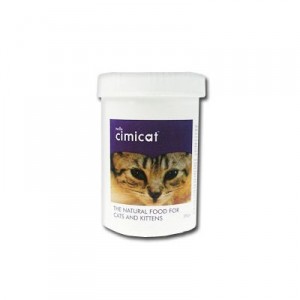
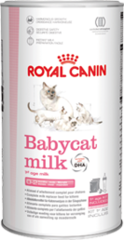
There are different kinds of milk replacer available but it is vital you use a high quality one specifically for kittens.
How often should hand reared kittens be fed?
- There will be a guide to follow on the tub of the milk replacer but remember that all the kittens are individuals and may suit slightly different regimes.
- As a general guide;
- 1-3 weeks – every 2 hours (yep, you’ll be up through the night!)
- 4-7 weeks – 10-12 times daily
- 8-10 weeks – 6 times daily.
- From about 4 weeks you can start to wean the kittens, but you should continue feeding the milk replacer as well.
- To wean we use a good quality kitten kibble and mix it with the milk replacer to make a porridge.
How much should they take each feed?
- Again, this depends very much on the kittens themselves, but as a general rule very young kittens, from day old to a week or so, may only take a few mls each feed, but as they grow, they can take upto 10ml each time.
- Use the instructions on the tub as a general guide.
- A full kitten will be nice and sleepy with a full belly. They will usually stop suckling when they have had enough.
- Hungry kittens are noisy! They will let you know when they need a feed!
- A good tip is to weigh the babies every day and record the results. Well fed, healthy kittens will grow and put on weight every day.
- If kittens are fed too much it can damage their kidneys (which will still be immature and not able to deal with large volumes of fluid) and give them diarrhoea.
- If kittens are fed too little they will quickly dehydrate, which can be fatal.
How to feed hand reared kittens
- There are plenty of different makes of feeding bottles on the market, so shop around.
- However, in our experience a lot of the bottles and teats are too large for tiny kittens to suckle on properly.
- We use a syringe with or without a teat on the end, depending on what the babies take to and if we can find one small enough.
- This way we can control the speed of the milk going in with the plunger and also easily measure the amount they are drinking.
- Always sit the kitten upright to feed and always ensure they are suckling. It is easy for the milk to dribble in even if they are not suckling and swallowing. If that occurs it can trickle into the lungs, which can be fatal.
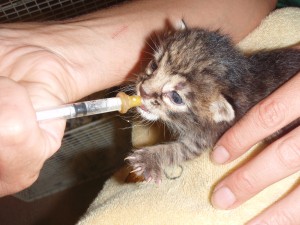
When they are very tiny we will often attach a teat to a syringe and feed them that way. This allows us to control the flow of the milk and accurately measure how much the babies are drinking.
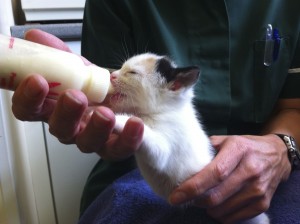
This is one of the kittens at feeding time! Always ensure you keep them upright and they are actively suckling on the bottle or syringe.
Keeping them clean!
- A mother cat will constantly be licking and cleaning her babies to keep them spotless. It is impossible to replicate this level of care but it is important to regularly clean the kittens.
- After every meal they should be ´Topped and Tailed´.
- Firstly, clean any dribbles from around their mouths and faces.
- Secondly, and this is the most important bit, rub their bottoms with a piece of cotton wool. This will stimulate the kitten to wee and poo. This keeps the guts moving and prevents them from becoming constipated. It is also very practical as it is easier to clean them at this stage than when they poo in their beds and then paddle in it!
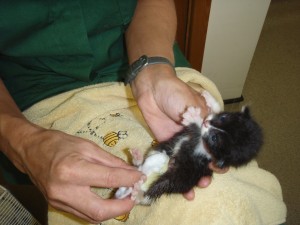
The kittens should have their bottoms rubbed with damp cotton wool after every meal to encourage them to wee and poo. It’s not glamorous but it is vital!
Where should you keep them?
- We tend to keep our kittens in a cat basket, one of the kinds with a top opening lid.
- The base is lined with several blankets and a hot water bottle. The most important thing is to keep the babies at a consistent, warm temperature.
- It also makes them nice and portable, as with feeding them every 2 hours, they are going to have to go everywhere with you!
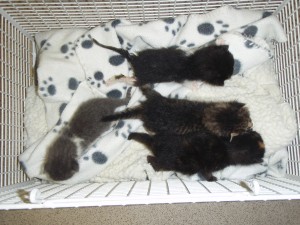
We keep our babies in a top opening wire cat carrier when they are tiny. There is more than enough room, they can be nice and snuggly, they are easy to keep an eye on and are very portable! Perfect!
Other Tips
- Closely monitor the kittens every day, weigh them, take note of their poo, appetites and activity levels. Any kitten which seems to be struggling or weak should be immediately separated from the rest of the litter and taken to the vets.
- CONSISTANCY is the key. ensuring the milk is the same each time, the feeds are regular and the routine of topping and tailing is stuck to.
- Hygiene is also vital, as with any young animal. Ensure the bottles, teats and syringes are kept scrupulously clean, and any poo in the basket is cleaned immediately.
- If you are in any doubt, ASK, your local vets should be your first point of call with any young litter of kittens, they will be a font of knowledge in this area and will be keen to help you.
What about weaning?
- You can start weaning from about 4 weeks old. This is slightly earlier than with normally reared kittens but hand reared tend to be quite independent and by this stage you’ll be desperate for them to have some meals without you helping them!
- Start by mixing a good quality dry kitten food with the milk replacer you have been using until it is a sloppy consistency.
- Place it in a low saucer on the floor and let the babies explore it. The idea is they will walk through it and then start to lick it off their paws. Be ready for the mess!
- The milk replacer helps to make the taste familiar and also ensures they continue to get enough calcium in their diets.
- Build up the porridge until they are on 3 solid meals a day (this will only take a couple of days once they get the hang of things!) but keep them on milk meals as well until they are at least 6 weeks old.
- We find it best, although initially we allow the kittens to explore the food together, to feed them separately until they are fully weaned. Otherwise the bigger ones will push the smaller ones out.
- Once they have reached 6 weeks, gradually reduce the amount of milk you put in the biscuits, so the consistency becomes firmer and firmer. By about 7-8 weeks old, when they are ready to go to their new homes, they should be on solid biscuits.
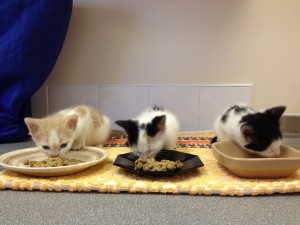
We find feeding the kittens separately is the best way to ensure they all get a good meal!
Hurrah! Now your babies are fully weaned and ready to go to their new homes! However, it is still vital to continue with a good quality, consistent diet to ensure they continue to grow and develop properly. Find out all about this next stage here!